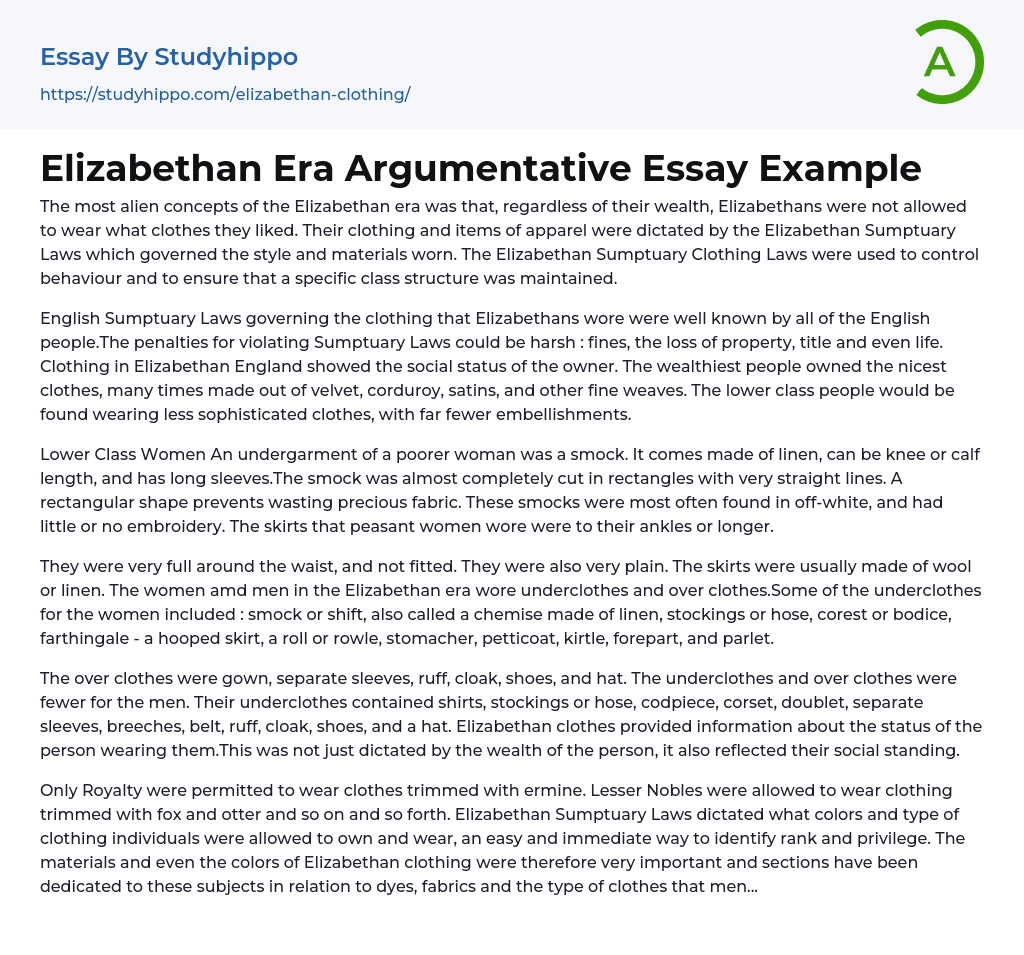During the Elizabethan era, there existed certain laws known as the Sumptuary Laws that regulated the clothing and accessories worn by Elizabethans, regardless of their financial status. These laws were put in place to maintain a specific social hierarchy and dictate acceptable materials and styles of attire.
English Sumptuary Laws were established in Elizabethan England to regulate citizens' clothing, with severe punishments for noncompliance. These laws were well-known throughout society, and an individual's social standing was indicated by their attire. The wealthiest wore luxury fabrics like velvet, corduroy, and satin while the working-class donned simpler clothing with fewer adornments.
Lower class women typically wore a simple linen smock as their undergarment, which could be knee or calf length and equipped with long sleeves. The smock was designed with rectangular shapes to avoid wasting fabric, and often c
...ame in plain off-white without any elaborate embroidery. Peasant women also typically wore long skirts that reached their ankles or went even further down.
During the Elizabethan era, both men and women wore loose-fitting, plain garments that often featured wool or linen materials. Women typically wore a variety of underclothes including a shift or chemise made of linen, stockings or hose, corset or bodice, a hooped skirt called a farthingale, a roll or rowle, stomacher, petticoat, kirtle, forepart, and parlet.
The Elizabethan era featured a variety of garments, including gowns, separate sleeves, ruffs, cloaks, shoes, and hats. Men had fewer under and outer clothes, consisting of shirts, stockings or hose, codpieces, corsets, doublets, breeches, belts, ruffs, cloaks, shoes, and hats. These outfits served not only as a display of wealth but also as an indicator of social status.
During the Elizabethan era, only
Royalty had the privilege of wearing ermine-trimmed clothes while Lesser Nobles were limited to clothing trimmed with fox, otter, and so on as dictated by the Sumptuary Laws. These laws specified the colors and types of clothing allowed for individuals based on their rank and privilege, making the materials and colors of clothing significant in identifying one's status. Dedicated sections on dyes, fabrics, and men's clothing discuss these aspects in detail.
- Jeans essays
- John Locke essays
- 9/11 essays
- A Good Teacher essays
- A Healthy Diet essays
- A Modest Proposal essays
- A&P essays
- Academic Achievement essays
- Achievement essays
- Achieving goals essays
- Admission essays
- Advantages And Disadvantages Of Internet essays
- Alcoholic drinks essays
- Ammonia essays
- Analytical essays
- Ancient Olympic Games essays
- APA essays
- Arabian Peninsula essays
- Argument essays
- Argumentative essays
- Art essays
- Atlantic Ocean essays
- Auto-ethnography essays
- Autobiography essays
- Ballad essays
- Batman essays
- Binge Eating essays
- Black Power Movement essays
- Blogger essays
- Body Mass Index essays
- Book I Want a Wife essays
- Boycott essays
- Breastfeeding essays
- Bulimia Nervosa essays
- Business essays
- Business Process essays
- Canterbury essays
- Carbonate essays
- Catalina de Erauso essays
- Cause and Effect essays
- Cesar Chavez essays
- Character Analysis essays
- Chemical Compound essays
- Chemical Element essays
- Chemical Substance essays
- Cherokee essays
- Cherry essays
- Childhood Obesity essays
- Chlorine essays
- Classification essays




